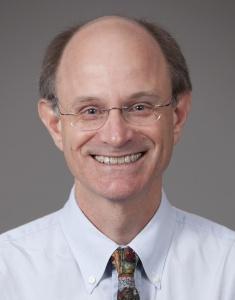
John W. Williams, MD, MHSc, is the subject of this week’s faculty spotlight. In this interview, Williams talks about directing the Durham VA Evidence Synthesis Center, implementing mental health care into patient-centered medical homes, the 1989 SGIM Conference in New Orleans and hiking Mount Kilimanjaro.
How long have you been at Duke? How long have you been at the division of General Internal Medicine?
I came to Duke as a fellow in 1988, left at the end of 1991 for a faculty position in San Antonio, and returned to the division in July of 2001.
What are your responsibilities within the division? What does a typical day for you look like?
I have research, clinical, and teaching responsibilities, as well as a few others. On the research side, I direct the Durham VA Evidence Synthesis Center, and co-investigate on the Duke CTSA award as well as other systematic reviews and primary data collection studies. Historically, my research focus has been on improving the detection, treatment and outcomes of patients with mental illness who are seen in primary care settings.
Clinically, I’m privileged to supervise our internal medicine housestaff in the VA PRIME Clinic. My teaching responsibilities include co-directing the CRTP master’s degree program, where I supervise the research project for about 40 master’s candidates annually and direct or co-direct two courses (Introduction to Clinical research methods; Systematic Reviews and meta-analyses).
Finally, I’m the Scientific Editor for the North Carolina Medical Journal, an associate editor for the AHRQ-funded Evidence-based Practice Program, and a medical editor for Healthwise. I also enjoy teaching research methods in the classroom environment
The bottom line is that I really don’t have a “typical day.”
You were part of a panel discussing integrating mental health into patient-centered medical homes for the SGIM conference earlier this spring. Can you tell me more about this discussion?
The focus was on the VA’s effort to implement integrated mental health-primary care in the context of the cultural transformation into a Patient Centered Medical Home (PCMH) model of care. The good news is that integrated care and PCMH are derived from the same conceptual models of how best to organize care, so the fit is natural. That doesn’t make reorganizing care easy, and although we’ve made progress, there is much to do to achieve the models full potential. The workshop focused on strategies to make this happen.
This discussion ties into your long-standing interest in improving how mental health services are implemented. What do you see as the biggest challenges and opportunities in this area right now?
We have models that work (e.g., integrated care models) but implementation has been slow outside of large healthcare systems. We need to adapt these models to capitalize on technology (e.g., electronic health records, internet or mobile device data collection, web-based psychotherapy) and decrease the work to implement these models. Once implemented, primary care physicians typically feel empowered and revel in their ability to provide better care.
Besides this panel, what was the most memorable experience at this year’s conference?
That’s easy. It was the Story Collider where SGIM Health Services Researchers told stories of science and clinical care – similar to Moth radio. I’ve started outlining ideas for my own story.
When and where was the first SGIM conference you went to? How did that experience compare to the 2015 meeting?
That’s a tough one because I’ve been going to these meetings for a long time. My guess is my first meeting was a Southern SGIM meeting in New Orleans, probably in 1989. That’s where I gave my first scientific presentations. It was a great learning lab and we had great food and sometimes Mardi Gras as a bonus.
What passions or hobbies do you have outside of the division?
Most people know that I love to hike to high places all over the world (like Mount Kilimanjaro) and generally like outdoor pursuits (kayaking, biking, backpacking). I also play piano and am preparing for a duet in two weeks. I also play in a trio with a cellist and violinist (strictly amateur, but fun).
Have you recently read any books, articles, blog posts or other material that would be of interest to the division?
I’d recommend Boys in the Boat by Daniel Brown – describing the 1936 eight-man crew team that won the Olympic Gold medal with Hitler gazing on. I’ve also just started Six Months in Sudan: A Young Doctor in a War-Torn Village. I’m already marveling about the storyteller’s courage and wondering about his motivations. I rely on my children to recommend good books.
Dr. Williams pauses on the Shira plains, Western Breach route to the top of Mount Kilimanjaro in Tanzania. During the hike, Dr. Williams slept in the volcanic crater at 18,800 feet.